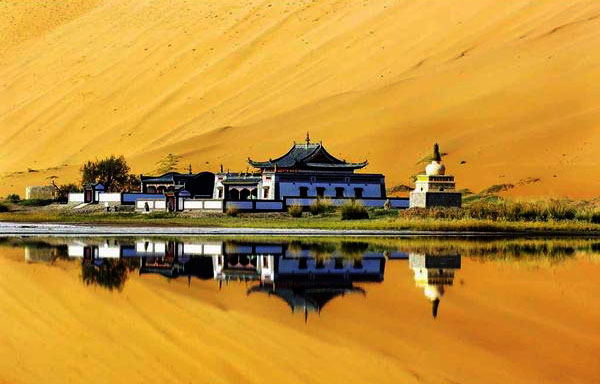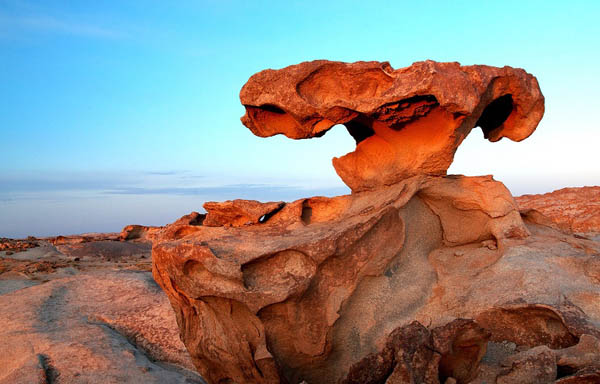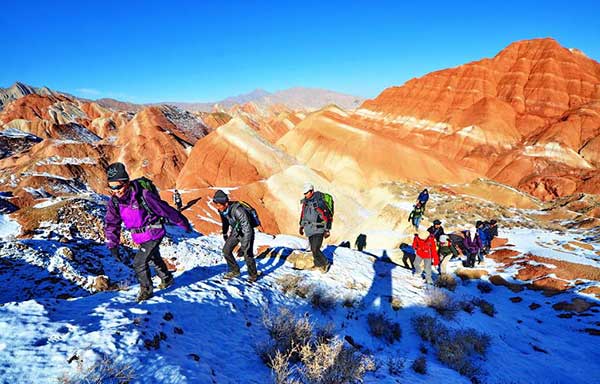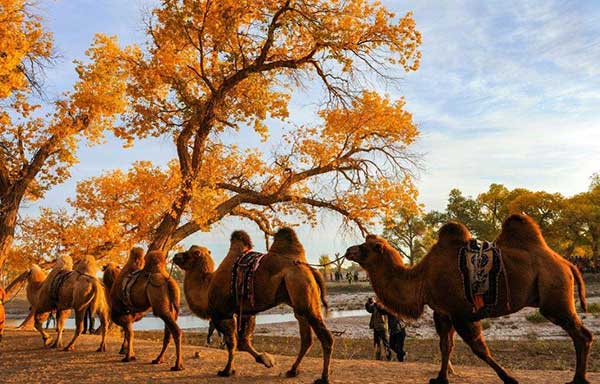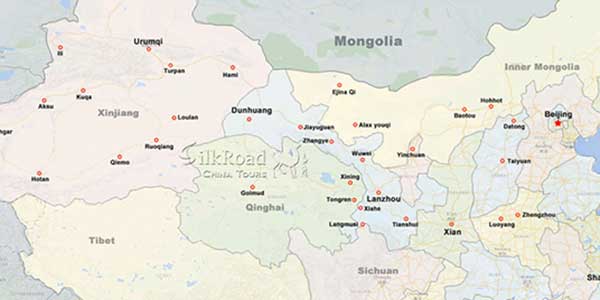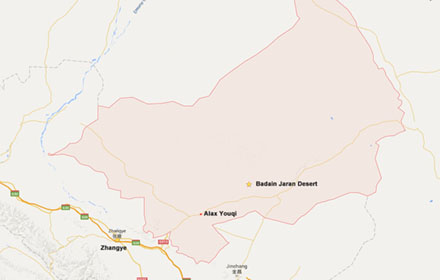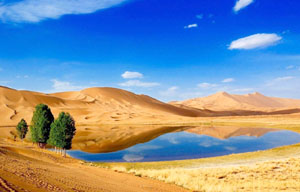 he Badain Jaran Desert (Chinese: 巴丹吉林沙漠) is a desert in Alxa youqi ( in inner mongolia). which spans the provinces of Gansu, Ningxia and Inner Mongolia. It covers an area of 49,000 sq. kilometers (19,000 sq. miles). By size it is the third largest desert in China.
he Badain Jaran Desert (Chinese: 巴丹吉林沙漠) is a desert in Alxa youqi ( in inner mongolia). which spans the provinces of Gansu, Ningxia and Inner Mongolia. It covers an area of 49,000 sq. kilometers (19,000 sq. miles). By size it is the third largest desert in China.
This desert is home to some of the tallest stationary dunes on Earth. Some reaching a height of more than 500 meters (1,600 ft.) although most average at around 200 meters. Its tallest dune is also measured, from base to peak, as the world's third tallest dune and highest stationary dune in the world.
The desert also features over 100 spring-fed lakes that lie between the dunes, some of which are fresh water while others are extremely saline. These lakes give the desert its name which is Mongolian for "mysterious lakes". It is also crossed by one river, the Ruo Shui ("weak water"), which has formed an alluvial plain in the desert.
Measuring over 49000sq kilometers, the Badain Jaran Desert covers a significant part of the south-central part of the Inner Mongolia Autonomous Region as well as the North part of Gansu province. Located in the Alxa Plateau at about 1200 meters above sea level it is listed as a subsection to the Gobi Desert. It is bound to the north by the Gobi and to the East by Mount Lang which separates it from the Ulan Buh Desert (乌兰布和沙漠)
Although most of the dunes in the desert are not stationary, the larger ones usually ranging above 200 meters are static. With these dunes only the shallow surface of the sand is constantly shifting. The middle and lower layers of the highest dunes have been compacted for more than 20,000 years causing the sand particles to harden resulting in solid layers of sand and sandstone. High moisture levels inside the dunes also contribute to maintain their fixed state. This rigid structure also allows peaks, cliffs, gullies and even caves to form as a result of water erosion and desertification.
The Badain Jaran Desert, like the Tengger Desert which lies to the east (and with which the Badain Jaran Desert is currently merging with, due to extensive desertification) is about one-half barren, sandy desert and one-half a mixture of solid bedrock and loose gravel. Several small lakes and oases scatter the desert around which limited vegetation is able to grow.
Lakes in The Badain Jaran Desert
The Badain Jaran Desert is well known for its numerous scattered and colorful lakes. Containing more than 140 lakes they are mainly found in the southern region in the desert. These lakes can easily be found in the larger valleys between large dunes. They are believed to provide the life sustenance in the desert supporting camels, goats and horses which are herded by nomads that travel through the desert. Most lakes also support a green ring of vegetation that populate the close vicinity around the lakes.
Some lakes throughout the desert change color due to large populations of algae, Brine shrimp and mineral formations at different times in year. Evaporation can also allow others to turn into a hypersaline lake forming a salt crust around the rim of the lake.
Although their true sources are still debated it is believed that they are being maintained by underground water streams. Most arid deserts in China are surrounded by mountains that provide water sources, and this is the case with the Badain Jaran Desert. Runoff from the mountains is then collected through gravel deposits and this allows them to run through the desert, providing water sources for the scattered oases.
Within the desert there can be two main types of lakes found regarding their morphometry. The largely elongated shallow lakes mainly appear in the megadune area in the southeastern margin of the desert. Their depth often reaches less than 2 meters and only measure about .2 square kilometers. The oval-shaped, deep lakes can also be found in the compound transverse megadune area. Their maximum depth reaches around 15 meters and attain a maximum size of around 1.5 square kilometers. The lake water can be extremely saline. The shallow lakes in the southeastern region of the desert tend to have low salt concentration, averaging at less than 20 g/L. Other lakes can show higher salt concentrations going up to more than 330 g/L.
Singing Dunes in The Badain Jaran Desert
The Badain Jaran megadunes is one of the few places where a phenomenon known as the "singing sand dunes", "whistling sands" or "booming dunes". This rare occasion emits a sharp, loud noise that can be maintained for more than a minute. Although it is not widely understood it is believed that it is caused by an electrostatic charge that is generated as wind pulls the top layers of sand down a dune slope. This will produce a low pitched rumble that can reach over 105 decibels. The singing dunes will manifest itself by initiating an avalanche of sand down the leeward face of a large dune. This phenomenon however, does require very specific circumstances in order to generate the sound. They are silent throughout winter when the humidity is being retained in the sand. In the summer however, the booming can be generated but only on a slope of at least 30 degrees or more, on the leeward face of a dune, and the same sand on the shallow, windward side cannot generate any noise. This phenomenon is only shared by around 35 other beaches and deserts around the world.
Under the same circumstances, it is also possible to generate another acoustic phenomenon. By moving a hand gently through the dry sand of a "booming sand dune", this will shear the upper layer of sand off the slope and generate a burping sound emission (pulse-like, short bursts of sound).
Dunes in The Badain Jaran Desert
The Badain Jaran Desert is made up of hundreds of dunes ranging from small to large. Most of the megadunes in the desert average about 400 meters from the base while the rest average around 200 meters. Out of all the megadunes, the Bilutu Peak (bì lǔ tú fēng) is the most famous. It towers at 500 meters from the base and is the tallest dune in Asia (third tallest in the world). Unlike most of the smaller dunes the Bilutu Peak is stationary which makes it the world's tallest stationary dune.
While the larger megadunes are stationary (with only the top layer of sand shifting), the smaller dunes are constantly shifting according to wind patterns. This makes desertification a problem in surrounding areas as the desert is constantly expanding.
History
Badain Jaran Humanoid traces (fossil remains, stone implements, etc.) from the Paleolithic ("Old Stone Age", or from about 2.6 million years ago to about 10 thousand years ago, which latter date marks the beginning of the Neolithic ("New Stone Age")) have been unearthed here, as well as the fossil remains of prehistoric members of the ostrich family (Struthionidae) and much, much older fossils belonging to dinosaurs. The aforementioned Tangut (táng gǔ tè 唐古特) tribes that resided here during China's earliest dynastic period, the Xia (BCE 2000-1500) Dynasty (xià cháo 夏朝), conducted trade with the Bactrians (BCE 2200-1700) of Central Asia (corresponding to the northern part of present-day Afghanistan, the western part of Tajikistan, most of present-day Turkmenistan, and the southern part of present-day Uzbekistan). The present-day camel of the Badain Jaran Desert is a descendant of the Bactrian camel.
In more recent times, the city of Alxa (Alashan in Tangut) and the He Xi Corridor formed part of the northern route of the ancient Silk Road. The Tang (CE 618-907) Dynasty poet, Wang Wei (wáng wéi 王维), wrote couplets on the subject of Alxa, and even the renowned Italian traveler and explorer, Marco Polo, left his own personal "Kilroy Was Here" on Alxa in the form of mention of Alxa's merits in his travel diaries. Later, Badain Jaran was occupied by the Mongols, and in particular, by nomadic desert tribes such as the Tuerhute (tǔ ěr hù tè 土尔扈特) and Heshuote (hé shuò tè 和硕特), who were excellent horsemen. Foreign and Chinese Archeology teams have unearthed numerous finds of stoneware pottery lying around the perimeter of the desert's many lakes, highlighting the importance of the lake as a site of early human habitation. Some of the later period pottery unearthed here had been painted.
Badain Jaran Temple
The Badain Jaran Desert has a well-preserved Tibetan-Buddhist temple – Badain Jaran Desert Temple, which was built in 1868. Since the temple lies in the heart of the desert - and, naturally, on the shores of a lake - it has remained untouched by the many wars that have marred or destroyed temples in other parts of the country. Badain Jaran Desert Temple, which measures some 300 square meters, has a modest library, several Buddhist frescoes, statues and wood carvings, as well as brick carvings and several other ancient artifacts related to the history of the temple. There is also a white pagoda standing to the west of the temple proper.
Gallery
Attractions in the area
Related Tours
General Information
Alias: No
Loc: 75 km from Alxa youqi
Entrance: 220+750 RMB
Open Time: 8:30—18:00
Relevant blogs
-
How did the name of Tianshui in Gansu come about?
The name Tianshui is very pleasant to the ear, and it reminds one of that exquisitely beautiful verse, "After getting drunk, one doesn't know if the sky is in
-
The 8th Silk Road Hotel Festival was successfully held i
On December 27th, the "8th Silk Road Hotel Festival" grandly opened at the Yujing International Hotel in Zhangye. This hotel festival gathered industry experts,
-
The Karez Irrigation System in Turpan has been selected
On September 3rd, at the 75th Executive Council Meeting of the International Commission on Irrigation and Drainage held in Sydney, Australia, the 2024 (11th bat
-
What is the connection between "dragons" and "snakes
In traditional Chinese culture, the snake has a dual identity of auspiciousness and danger. Ancient people believed that the snake not only possesses divine cha
-
Endangered Przewalski's Horses Spotted at Dunhuang Yume
<p>In early February, a group of special "visitors"—the Przewalski's horses—appeared at the Dunhuang Yumen Pass scenic area in Gansu Province, a U
-
The Fourth Dunhuang Cultural Tourism Supplier Conference
On the morning of February 18th, the Fourth Dunhuang Cultural Tourism Supplier Conference in Northwest China commenced at the Dunhuang International Convention






